
Rio de Janeiro ᛫ April 11 – 13 & 20 – 26, 2018
Enjoying the beach, samba music and drinking caipirinhas at the Copacabana. That’s often the first thought coming to mind when thinking of Rio de Janeiro. Even though that was also on my list of things to do in Rio, I didn’t care that much about it because my main objective was to meet my boyfriend Tarik. I arrived two days before him though and stayed with a Couchsurfing host.

The famous stairway called
Escadaria Selarón was created by artist Jorge Selarón. There are 215 steps, which are covered in over 2000 tiles, ceramics, and mirrors that were collected from over 60 countries around the world.
Getting to Know Rio…
From Recife, it was a 3-hour flight to Rio. After getting my backpack, I took an Uber taxi to my host’s place. Since he wasn’t at home at that time, he had left the door key at the reception. When I entered, his cat greeted me. Because I’m allergic and it was a one-room apartment, I quickly took a pill but was a little worried about the night. Thankfully, it was a pretty respectful cat that left me alone most of the time. 😉
Like my host in Recife, this couchsurfer also had a shared rooftop pool. Therefore, I was happy to be able to work out there. The best part was the view of Rio’s mountains from up there and you could even see the famous Christ statue.
When my host came home later, we got to know each other and he gave me tips on what to do in Rio. So the next day, I walked through the Arcos da Lapa, which were close to his place. And from there to the Escadaria Selarón. Before coming to Brazil I had heard many stories about its crime and Rio being one of the most dangerous places. So even though my host assured me it was safe to walk the 10 minutes from his place to the stairs, I still took some precautions.
…With Precautions
First of all, I only took what was absolutely necessary in a small purse. Since I wanted to buy some food, I took my credit card. I also had a second wallet with R$ 20 (4.5 €/US$ 5.3) in cash that I would have given away in case of a robbery. My camera and my main smartphone also had to stay at home. Instead, I brought an old phone that would be “ok” to be stolen.
Nonetheless, I made sure only to take it out when I really needed it and to hold it with both hands. Furthermore, I was more cautious than usual while walking on the street. I watched all the people closely and was very aware of my surroundings. On top, I was prepared to start running at any point if someone would have come to close to me. Luckily, everything was fine.
At the Escadaria Selarón, a beautiful stairway with hand-painted tiles, there were many tourists and it was safe to take out my phone. I could have even used my camera, but I didn’t want to risk losing it on the way there. So if you take a taxi to and from Rio’s most popular attractions, it’s ok to bring a camera. But if you walk around the city, only take the most important and/or stuff you can afford to lose.
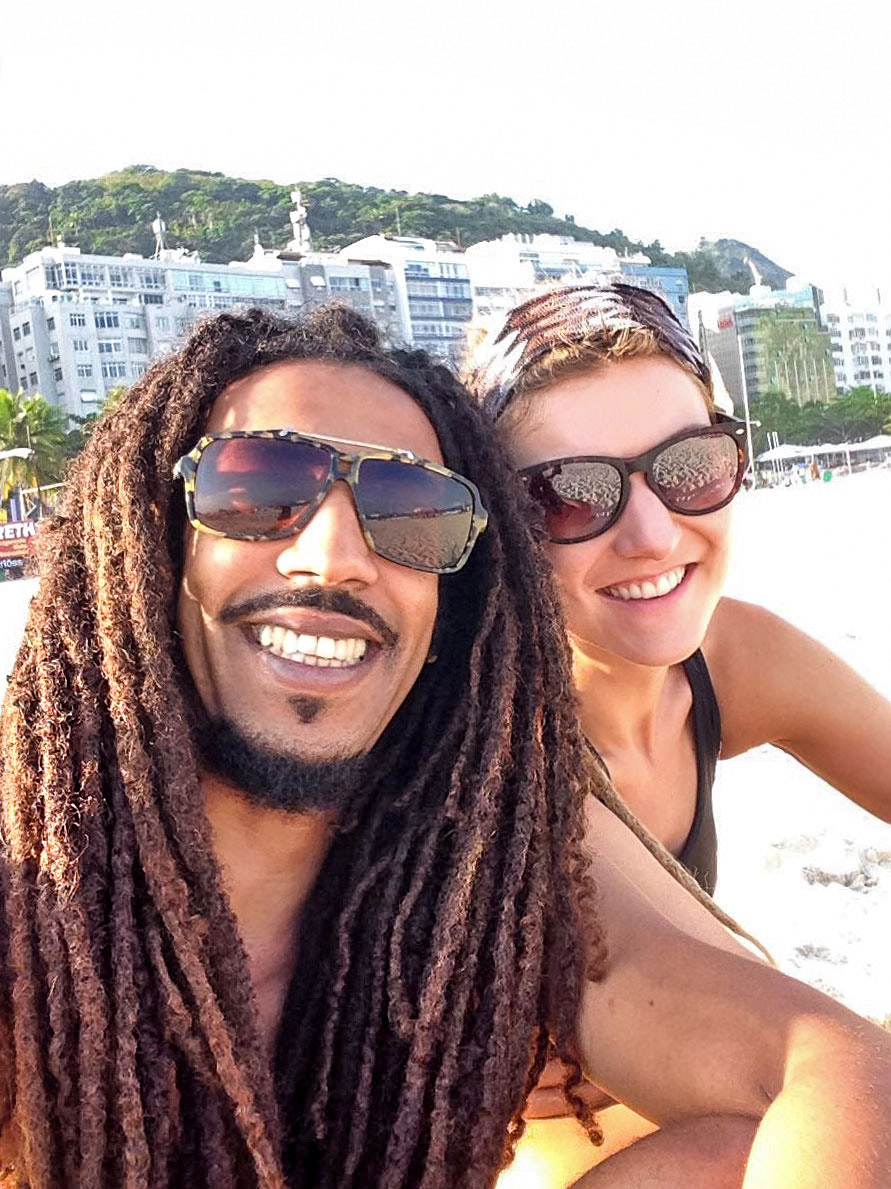
We had good times at the beach in Leme and Copacabana. In Brazil, you say: Praia do Leme & Praia de Copacabana. 🙂
Finally Reuniting with My Boyfriend Tarik
After two nights, I left the city again to go to Niterói. It’s a smaller city across the Guanabara Bay, connected to Rio by a huge bridge. My boyfriend Tarik and me had booked a nice Airbnb apartment there close to the beach because it was much cheaper than in Rio. Read more about our reunion >
During that week we tried to find couchsurfers to host both of us in Rio, but didn’t have any success. So we rented a very cheap Airbnb. After we had already booked it, the owner contacted us asking if we were ok with the location being in a comunidade (community). We didn’t know what that meant. So she explained to us that it’s another word for favela, but assured that it would be safe for us there. Favelas are Brazilian slums that are dangerous for anyone not living there. There are some favelas that not even policemen enter.
Moving to a Favela
On our way there, I was pretty nervous because so many people had warned me not to get close to any favelas. But I just hoped that the Airbnb woman was right and that everything was going to be all right. The apartment was located in Leme, which is right next to Copacabana. The Copacabana beach becomes Leme beach in the eastern part. Our Uber taxi drove close to the beach and past nice buildings that were all surrounded by gates and had safety doors.
Then we turned left and ascended a steep mountain. The houses looked different immediately; smaller, with fewer safety features and many were painted with colorful graffitis. It looked cool, but we knew we had entered the favela. When we arrived at the destination, we didn’t know right away which house it was because there were no house numbers. Therefore, I got my phone out carefully and called the owner while Tarik shielded me a bit and watched out. There were quite a few people on the street, hanging out, listening to music and eyeballing us.
Our Home for the Week
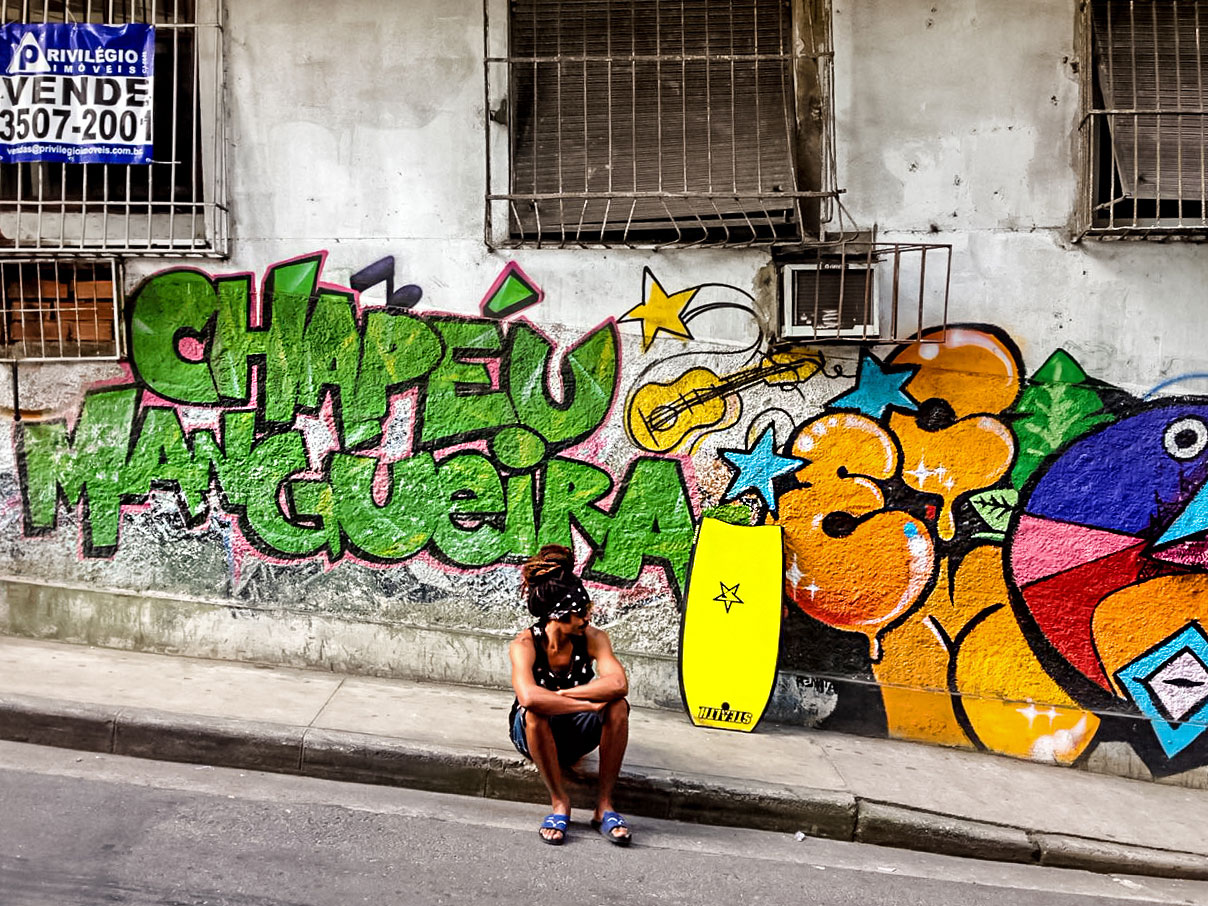
The name of the favela we stayed in was written on (at least) one of its buildings. Babilônia and Chapéu Mangueira were pacified and are now safe to visit.
But the owner came quickly and released us from what felt to me like an uncomfortable situation. We had to climb a couple of very steep and big steps, which was a little challenging with all of our bags. Our apartment had one room with a pullout couch, two chairs, a kitchenette, a small bathroom, and low ceilings.
For security, there was only a small door lock and one window couldn’t be locked up at all. It was simple, but like I mentioned before, very cheap and we had everything we needed. I was a little worried about our safety at first, but nothing negative happened to us. We even ended up staying for six nights instead of the planned two.
Safety in the Favela
The favela was called Babilônia/Chapéu Mangueira and was actually a great neighborhood. There was a football field and a martial arts studio across the street from our place. Hence, we often saw people working out and having fun there. On our street, there were also some small shops and restaurants that offered good and cheap products. Apart from lots of graffitis, there were also beautiful murals made out of mosaic tiles.

This big graffiti was right on the street corner where we stayed and we could see it from our windows.
In 2009, the Unidade de Polícia Pacificadora (Pacifying Police Unit) entered this favela and since then there has been a huge decline in crime. Today, this area is one of the safe favelas in Rio and armed police officers were present every day. Yet, “safe” is a relative word in Rio. On the street, you should be cautious and only take with you what’s necessary anywhere in the city, of course.
Despite being pacified, we still heard gunshots now and then. Some were far away, others sounded like coming from just a bit further up the mountain. Consequently, we stayed on the main street and neither went up nor followed our street deeper into the favela. So everything was fine.
The best part about our location and the reason for choosing it (apart from the price ;)) was its proximity to the beach. We only had to walk for five minutes! Returning took a little longer because we had to climb the mountain though. 😀
Leme & Copacabana Beach
The first things we saw when approaching the beach were two big rasta flags. They belonged to a food and drink booth and were there every day. As a result, we felt welcome immediately. The beach was nice and 4.6km/2.8mi long. Most of the time, we stayed in Leme closest to our “home”, but also went to Copacabana a couple of times. No idea where one ended and the other started though. 😉
This beach is world famous and we could understand why. In addition to its wide sandy area and blue waters filled with surfers and bodyboarders, there was something there for everyone. People playing volleyball, football or other games, working out, sipping cocktails, listening to music, hanging out with friends or just relaxing.
Every couple of meters, you could find a different barracas (small booths) that sold snacks, cocktails and other drinks. Some also played music. Besides those, you could choose from a seemingly endless flow of vendors walking up and down the beach, selling all different kinds of stuff; cold and hot food, drinks, toys, beach equipment etc.
Christ the Redeemer
While we were in Rio, we also had to visit Christ the Redeemer, of course. We took an Uber taxi up the mountain to the parking lot of the Tourist Information Center. From there, you either have to take a bus or the train to the statue. After making sure it was safe, we decided to walk. The scenery in the Tijuca Forest National Park was beautiful; lots of green vegetation on both sides of the road and different outlooks over Rio. We arrived after half an hour and paid the entrance fee of R$ 13 (2.9 €/US$ 3.4) per person. Then we ascended the mountain even more by elevator, escalators, and stairs.
When we reached the top, at last, we were stunned by the view. There were green mountains on one side, and the city and the ocean on the other. It was incredible to see this huge city from above. There are 6.5 million people living in the city and another 13 million in the metropolitan area.
Due to a clear view, we could look all the way across the Guanabara Bay to Niterói and even saw the mountain we had climbed in Itacoatiara. After enjoying the different outlooks, taking lots of pictures and eating ice cream, we took the bus back to the tourist center for free.
Being Stuck on the Mountain
From there we ordered an Uber taxi and waited for a long time. The battery of our phone was empty and we didn’t see that the driver had canceled the ride. This had never happened to me before. Consequently, I was surprised to see it when we went to the center to charge the phone. So we booked another driver, but he also canceled. The staff of the souvenir shop explained to us that Uber drivers usually don’t want to drive up all the way of the mountain.
Unfortunately, we didn’t have money for a normal taxi. We had only brought a little bit of local currency and Euros that we wanted to change after visiting the statue. Since you pay with your phone for Uber, we didn’t think we needed a credit card. It was already kind of late at that point and the money exchange places were already closed. Thankfully, the people working there were very friendly and helpful.
We had to wait until they closed down everything and then we could ride with them on the staff bus down the mountain for free! When we arrived, we could call an Uber that actually came and brought us back to Leme. And we also found a hotel not far from our place that exchanged our money. All’s well that ends well.
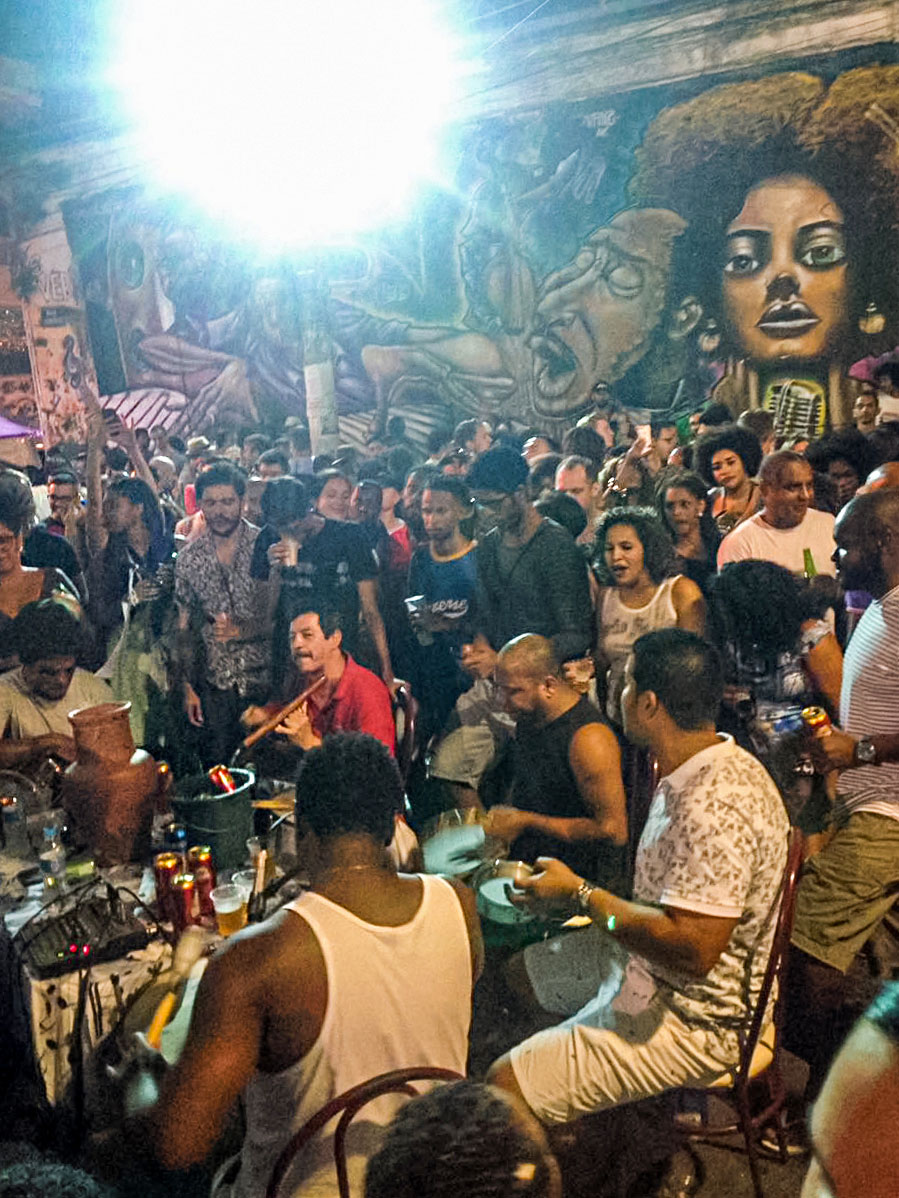
The musicians played Samba music at the bottom of Pedra do Sal. Many people surrounded them, dancing and singing along joyfully.
Samba Street Party Fun
Although we didn’t find a Couchsurfing host to stay with, we got an awesome recommendation from one that we contacted. So we made sure to check out Pedra do Sal (Rock of Salt) in an area known as “Little Africa”. We went on a Monday night and found a joyful street party. In the center, there was a big rock surrounded by houses. At its bottom, a group of musicians sat around a table, playing live Samba music. Surrounding them and on the rock, many people had fun, dancing and singing along.
In the neighboring streets, there were booths with drinks, also music and more people having a good time. I drank delicious Caipirinha, we danced and met new cool Brazilian friends. The live music stopped around 12 am, but the party on the streets was still going when we left around 2 am. We really enjoyed the atmosphere at Pedra do Sal and can recommend visiting this place to anyone who wants to experience an authentic Brazilian street party.
In conclusion, we really liked Rio and enjoyed our time there. We were especially impressed by its friendly people and colorful street art. Yet, there are many more things to do and visit in this big city. So we will be sure to visit this lovely place again before leaving Brazil. Our next destination was the lovely beach town Peruíbe.
Enjoying the beach, samba music and drinking caipirinhas at the Copacabana. That’s often the first thought coming to mind when thinking of Rio de Janeiro. Even though that was also on my list of things to do in Rio, I didn’t care that much about it because my main objective was to meet my boyfriend Tarik. I arrived two days before him though and stayed with a Couchsurfing host.
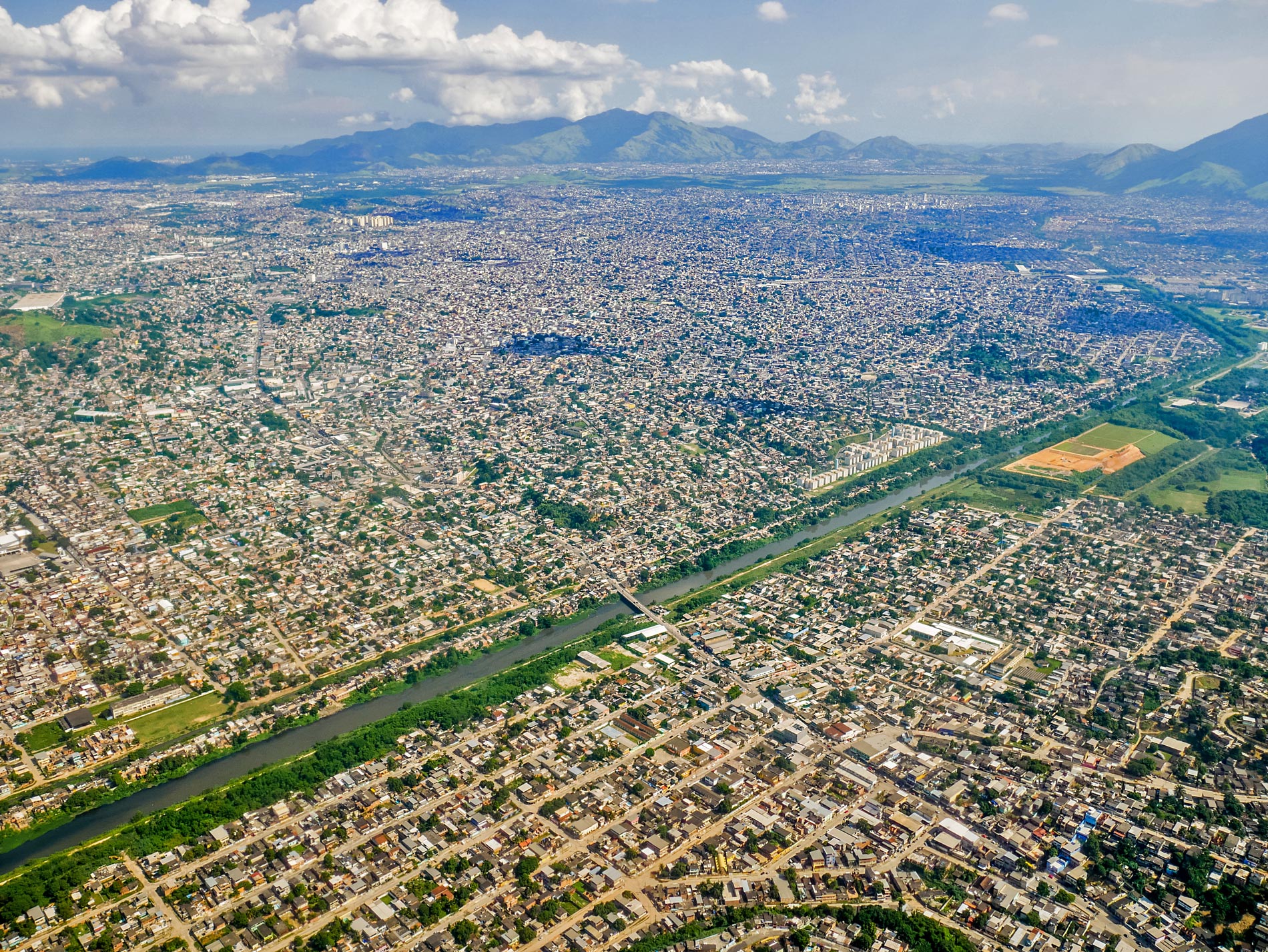
It was incredible to see this huge city from the top while the plane started to descend. Rio just seemed to be endless. There are 6.5 million people living in the city and another 13 million in the metropolitan area.
Getting to Know Rio…
From Recife, it was a 3-hour flight to Rio. After getting my backpack, I took an Uber taxi to my host’s place. Since he wasn’t at home at that time, he had left the door key at the reception. When I entered, his cat greeted me. Because I’m allergic and it was a one-room apartment, I quickly took a pill but was a little worried about the night.
Thankfully, it was a pretty respectful cat that left me alone most of the time. 😉 Like my host in Recife, this couchsurfer also had a shared rooftop pool. Therefore, I was happy to be able to work out there. The best part was the view of Rio’s mountains from up there and you could even see the famous Christ statue.
When my host came home later, we got to know each other and he gave me tips on what to do in Rio. So the next day, I walked through the Arcos da Lapa, which were close to his place. And from there to the Escadaria Selarón. Before coming to Brazil I had heard many stories about its crime and Rio being one of the most dangerous places. So even though my host assured me it was safe to walk the 10 minutes from his place to the stairs, I still took some precautions.

The famous stairway called
Escadaria Selarón was created by artist Jorge Selarón. There are 215 steps, which are covered in over 2000 tiles, ceramics, and mirrors that were collected from over 60 countries around the world.
…With Precautions
First of all, I only took what was absolutely necessary in a small purse. Since I wanted to buy some food, I took my credit card. I also had a second wallet with R$ 20 (4.5 €/US$ 5.3) in cash that I would have given away in case of a robbery. My camera and my main smartphone also had to stay at home. Instead, I brought an old phone that would be “ok” to be stolen.
Nonetheless, I made sure only to take it out when I really needed it and to hold it with both hands. Furthermore, I was more cautious than usual while walking on the street. I watched all the people closely and was very aware of my surroundings. On top, I was prepared to start running at any point if someone would have come to close to me. Luckily, everything was fine.
At the Escadaria Selarón, a beautiful stairway with hand-painted tiles, there were many tourists and it was safe to take out my phone. I could have even used my camera, but I didn’t want to risk losing it on the way there. So if you take a taxi to and from Rio’s most popular attractions, it’s ok to bring a camera. But if you walk around the city, only take the most important and/or stuff you can afford to lose.
Finally Reuniting with My Boyfriend Tarik
After two nights, I left the city again to go to Niterói. It’s a smaller city across the Guanabara Bay, connected to Rio by a huge bridge. My boyfriend Tarik and me had booked a nice Airbnb apartment there close to the beach because it was much cheaper than in Rio. Read more about our reunion >

We had good times at the beach in Leme and Copacabana. In Brazil, you say: Praia do Leme & Praia de Copacabana. 🙂
During that week we tried to find couchsurfers to host both of us in Rio, but didn’t have any success. So we rented a very cheap Airbnb. After we had already booked it, the owner contacted us asking if we were ok with the location being in a comunidade (community). We didn’t know what that meant. So she explained to us that it’s another word for favela, but assured that it would be safe for us there. Favelas are Brazilian slums that are dangerous for anyone not living there. There are some favelas that not even policemen enter.
Moving to a Favela
On our way there, I was pretty nervous because so many people had warned me not to get close to any favelas. But I just hoped that the Airbnb woman was right and that everything was going to be all right. The apartment was located in Leme, which is right next to Copacabana. The Copacabana beach becomes Leme beach in the eastern part. Our Uber taxi drove close to the beach and past nice buildings that were all surrounded by gates and had safety doors.

This big graffiti was right on the street corner where we stayed and we could see it from our windows.
Then we turned left and ascended a steep mountain. The houses looked different immediately; smaller, with fewer safety features and many were painted with colorful graffitis. It looked cool, but we knew we had entered the favela.
When we arrived at the destination, we didn’t know right away which house it was because there were no house numbers. Therefore, I got my phone out carefully and called the owner while Tarik shielded me a bit and watched out. There were quite a few people on the street, hanging out, listening to music and eyeballing us.
Our Home for the Week
But the owner came quickly and released us from what felt to me like an uncomfortable situation. We had to climb a couple of very steep and big steps, which was a little challenging with all of our bags. Our apartment had one room with a pullout couch, two chairs, a kitchenette, a small bathroom, and low ceilings.
For security, there was only a small door lock and one window couldn’t be locked up at all. It was simple, but like I mentioned before, very cheap and we had everything we needed. I was a little worried about our safety at first, but nothing negative happened to us. We even ended up staying for six nights instead of the planned two.
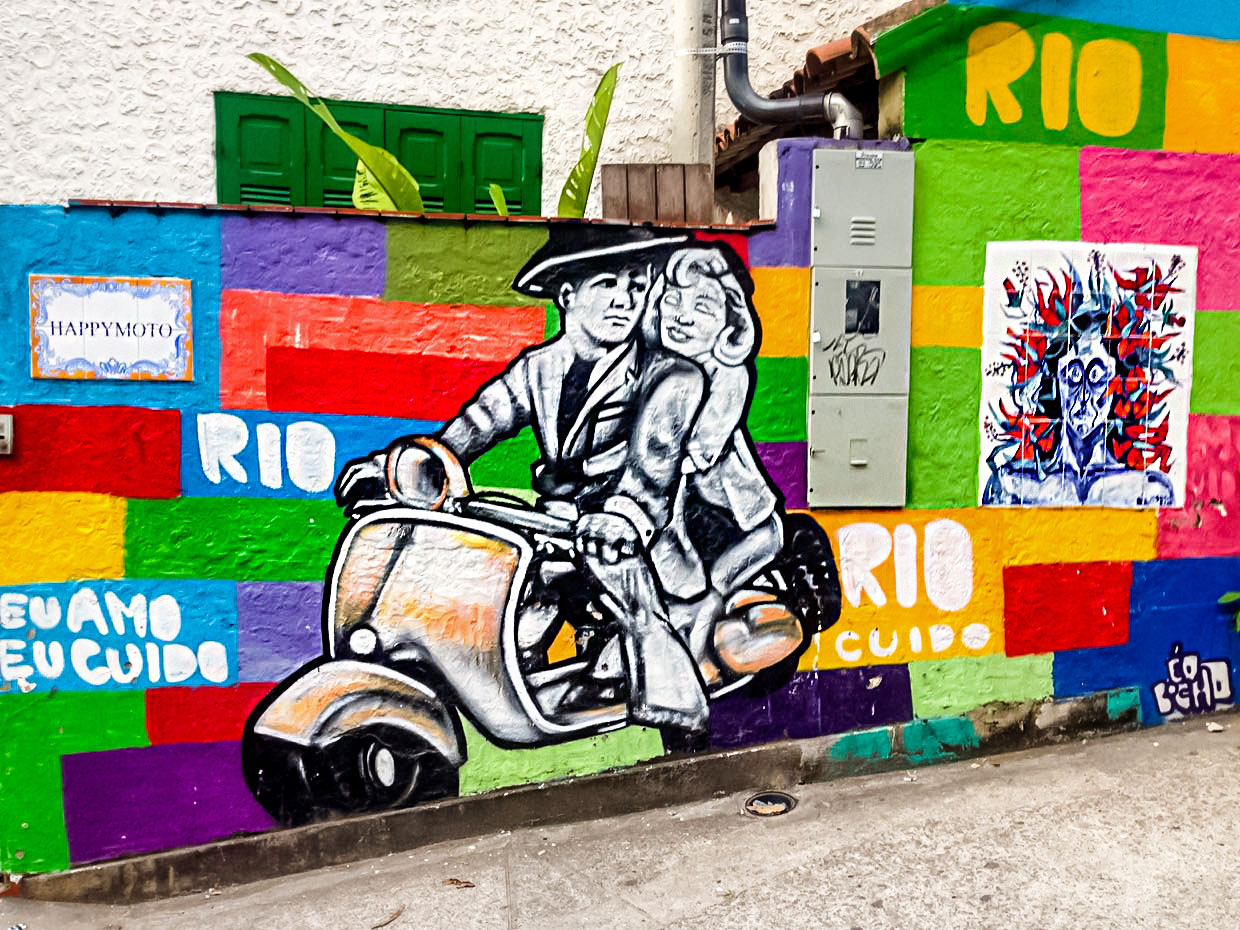
This mural in the favela was painted in vivid colors. “Eu amo” (on the left) means “I love” and “Eu cuido” can be translated with “I take care”.
Safety in the Favela
The favela was called Babilônia/Chapéu Mangueira and was actually a great neighborhood. There was a football field and a martial arts studio across the street from our place. Hence, we often saw people working out and having fun there. On our street, there were also some small shops and restaurants that offered good and cheap products. Apart from lots of graffitis, there were also beautiful murals made out of mosaic tiles.
In 2009, the Unidade de Polícia Pacificadora (Pacifying Police Unit) entered this favela and since then there has been a huge decline in crime. Today, this area is one of the safe favelas in Rio and armed police officers were present every day. Yet, “safe” is a relative word in Rio. On the street, you should be cautious and only take with you what’s necessary anywhere in the city, of course.

The name of the favela we stayed in was written on (at least) one of its buildings. Babilônia and Chapéu Mangueira were pacified and are now safe to visit.
Despite being pacified, we still heard gunshots now and then. Some were far away, others sounded like coming from just a bit further up the mountain. Consequently, we stayed on the main street and neither went up nor followed our street deeper into the favela. So everything was fine. The best part about our location and the reason for choosing it (apart from the price ;)) was its proximity to the beach. We only had to walk for five minutes! Returning took a little longer because we had to climb the mountain though. 😀
Leme & Copacabana Beach
The first things we saw when approaching the beach were two big rasta flags. They belonged to a food and drink booth and were there every day. As a result, we felt welcome immediately. The beach was nice and 4.6km/2.8mi long. Most of the time, we stayed in Leme closest to our “home”, but also went to Copacabana a couple of times. No idea where one ended and the other started though. 😉
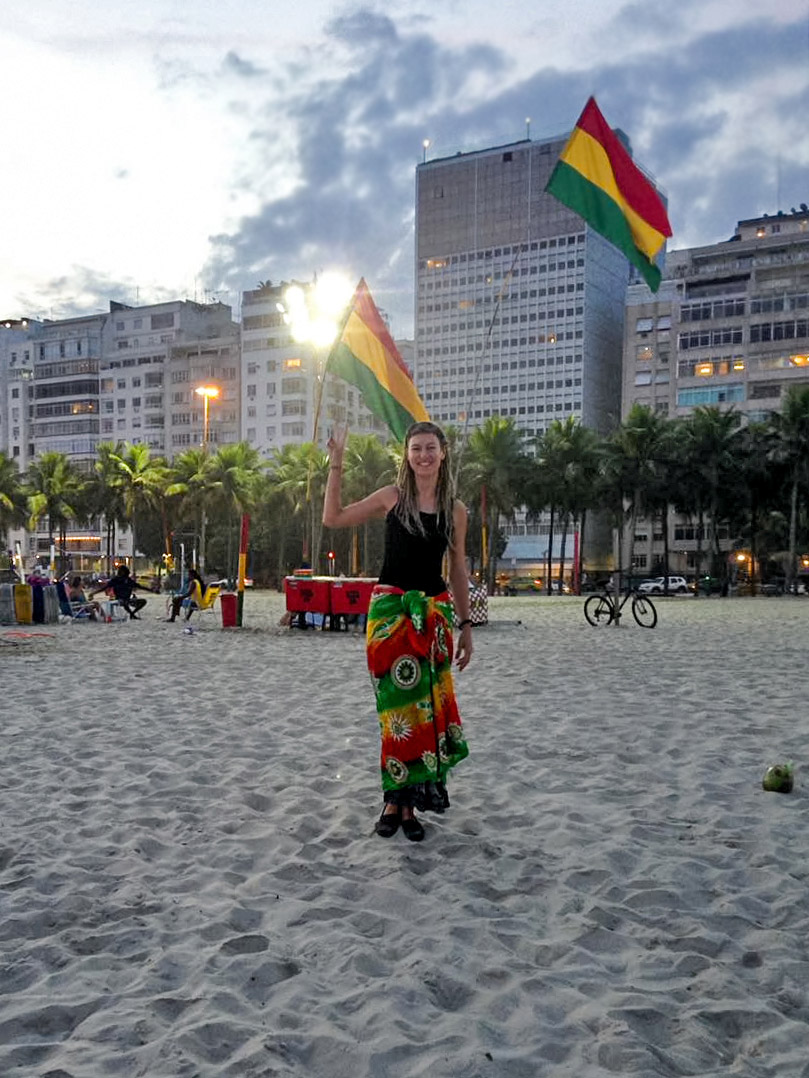
At the beach section closest to our place, we found two big rasta flags. Lots of peace, love and positive vibes! 🙂
This beach is world famous and we could understand why. In addition to its wide sandy area and blue waters filled with surfers and bodyboarders, there was something there for everyone. People playing volleyball, football or other games, working out, sipping cocktails, listening to music, hanging out with friends or just relaxing.
Every couple of meters, you could find a different barracas (small booths) that sold snacks, cocktails and other drinks. Some also played music. Besides those, you could choose from a seemingly endless flow of vendors walking up and down the beach, selling all different kinds of stuff; cold and hot food, drinks, toys, beach equipment etc.
Christ the Redeemer
While we were in Rio, we also had to visit Christ the Redeemer, of course. We took an Uber taxi up the mountain to the parking lot of the Tourist Information Center. From there, you either have to take a bus or the train to the statue. After making sure it was safe, we decided to walk.
The scenery in the Tijuca Forest National Park was beautiful; lots of green vegetation on both sides of the road and different outlooks over Rio. We arrived after half an hour and paid the entrance fee of R$ 13 (2.9 €/US$ 3.4) per person. Then we ascended the mountain even more by elevator, escalators, and stairs.
When we reached the top, at last, we were stunned by the view. There were green mountains on one side and the city and the ocean on the other. It was incredible to see this huge city from above. There are 6.5 million people living in the city and another 13 million in the metropolitan area.
Due to a clear view, we could look all the way across the Guanabara Bay to Niterói and even saw the mountain we had climbed in Itacoatiara. After enjoying the different outlooks, taking lots of pictures and eating ice cream, we took the bus back to the tourist center for free.
Being Stuck on the Mountain
From there we ordered an Uber taxi and waited for a long time. The battery of our phone was empty and we didn’t see that the driver had canceled the ride. This had never happened to me before. Consequently, I was surprised to see it when we went to the center to charge the phone. So we booked another driver, but he also canceled. The staff of the souvenir shop explained to us that Uber drivers usually don’t want to drive up all the way of the mountain.
Unfortunately, we didn’t have money for a normal taxi. We had only brought a little bit of local currency and Euros that we wanted to change after visiting the statue. Since you pay with your phone for Uber, we didn’t think we needed a credit card. It was already kind of late at that point and the money exchange places were already closed. Thankfully, the people working there were very friendly and helpful.
We had to wait until they closed down everything and then we could ride with them on the staff bus down the mountain for free. When we arrived, we could call an Uber that actually came and brought us back to Leme. And we also found a hotel not far from our place that exchanged our money. All’s well that ends well.
Samba Street Party Fun

The musicians played Samba music at the bottom of Pedra do Sal. Many people surrounded them, dancing and singing along joyfully.
Although we didn’t find a Couchsurfing host to stay with, we got an awesome recommendation from one that we contacted. So we made sure to check out Pedra do Sal (Rock of Salt) in an area known as “Little Africa”. We went on a Monday night and found a joyful street party. In the center, there was a big rock surrounded by houses. At its bottom, a group of musicians sat around a table, playing live Samba music. Surrounding them and on the rock, many people had fun, dancing and singing along.
In the neighboring streets, there were booths with drinks, also music and more people having a good time. I drank delicious Caipirinha, we danced and met new cool Brazilian friends. The live music stopped around 12 am, but the party on the streets was still going when we left around 2 am. We really enjoyed the atmosphere at Pedra do Sal and can recommend visiting this place to anyone who wants to experience an authentic Brazilian street party.

At the street party near Pedra do Sal, we met some really nice Brazilians. Needless to say, we had a fun time with our new friends.
In conclusion, we really liked Rio and enjoyed our time there. We were especially impressed by its friendly people and colorful street art. Yet, there are many more things to do and visit in this big city. So we will be sure to visit this lovely place again before leaving Brazil. Our next destination was the lovely beach town Peruíbe.
See More Pictures of Our Time in Rio de Janeiro
Rio de Janeiro – View from the Plane
It was incredible to see this huge city from the top while the plane started to descend. Rio just seemed to be endless. There are 6.5 million people living in the city and another 13 million in the metropolitan area.
Rio de Janeiro – New Brazilian Friends
At the street party near Pedra do Sal, we met some really nice Brazilians. Needless to say, we had a fun time with our new friends.
Rio de Janeiro – With a Policewoman in a Favela
There were several armed police officers present in the favela every day. This policewoman agreed to take a picture with Tarik just across the street from were we lived.
Rio de Janeiro – At the Escadaria Selarón
Sitting on the beautiful steps that are covered in fragments of mostly blue, green and yellow tiles – the colors of the Brazilian flag.
Rio de Janeiro – Colorful Graffiti in Favela
This mural in the favela was painted in vivid colors. “Eu amo” (on the left) means “I love” and “Eu cuido” can be translated with “I take care”.
Rio de Janeiro – Colorful Mosaic Mural in Favela
There were not only graffitis in the favela Babilônia/Chapéu Mangueira, but also mosaic murals like this colorful butterfly.
Rio de Janeiro – Rasta Flags at the Beach
At the beach section closest to our place, we found two big rasta flags. Lots of peace, love and positive vibes! 🙂
Rio de Janeiro – On the Way to the Christ Statue
So much green: On our way to visit the statue of Christ the Redeemer.
Rio de Janeiro – A Green Walk Up
Walking up Corcovado mountain through the Tijuca Forest National Park to the Christ monument. In addition to seeing lots of green, we also caught some glimpses of the city now and then.
Rio de Janeiro – Almost at the Statue of Christ the Redeemer
Almost there: Climbing the final steps to the Statue of Christ the Redeemer.
Rio de Janeiro – Christ the Redeemer or Cristo Redentor
There he is! Rio’s most famous statue is called Cristo Redentor, or Christ the Redeemer in English. It is 30m/98ft tall and the arms stretch 28m/92ft wide. The pedestal adds another 8m/26ft to its height.
Rio de Janeiro – View from the Christ Statue
The amazing view of Rio de Janeiro and the Guanabara Bay from the Christ statue on top of Corcovado mountain.
Rio de Janeiro – Mandatory Cristo Redentor Picture 😉
Must-Dos in Rio: Visit the Christ statue and take a picture spreading your arms. 😉
Rio de Janeiro – Overlooking the City and Ocean
From the Corcovado mountain in the Tijuca Forest National Park we had amazing views over the city. In this picture, Tarik is looking at the mountain Dois Irmãos (two brothers) and Rio’s horse race track.
Rio de Janeiro – View from the Top
Rio from the top: The long stretch next to the ocean on the right of the picture is Copacabana and Leme in the middle. On the left of that is the famous Pão de Açúcar (Sugarloaf Mountain). Behind it you can see Niterói, where we spent the first week.
Rio de Janeiro – Busts
Just one level below the Christ statue, we found busts of two men who were responsible for the monument. Cardinal Dom Sebastião Leme (left) was mentor and supporter of the construction, and Heitor da Silva Costa was the civil engineer, designer and constructor.
Rio de Janeiro – Mountain View
Standing on top of Corcovado mountain, which is part of the Tijuca Forest National Park. Apart from stunning outlooks over the city, we also got to see nice mountain ranges.
Rio de Janeiro – Street Party at Pedra do Sal
View of the street party from the rock itself. Behind the palm tree, musicians played live music and everybody enjoyed themselves.
Rio de Janeiro – Street Art Mural
Before taking pictures like this, I made sure that nobody was close to me. Then I took out my phone carefully and shot the photo as quickly as possible. Rio’s street art was to beautiful to resist. 😉
Rio de Janeiro – Graffiti
There were lots of beautiful graffitis and murals all over the city. We like street art a lot because it brightens up otherwise dull walls.
Rio de Janeiro – View from the Plane
It was incredible to see this huge city from the top while the plane started to descend. Rio just seemed to be endless. There are 6.5 million people living in the city and another 13 million in the metropolitan area.
Rio de Janeiro – New Brazilian Friends
At the street party near Pedra do Sal, we met some really nice Brazilians. Needless to say, we had a fun time with our new friends.
Rio de Janeiro – With a Policewoman in a Favela
There were several armed police officers present in the favela every day. This policewoman agreed to take a picture with Tarik just across the street from were we lived.
Rio de Janeiro – At the Escadaria Selarón
Sitting on the beautiful steps that are covered in fragments of mostly blue, green and yellow tiles – the colors of the Brazilian flag.
Rio de Janeiro – Colorful Graffiti in Favela
This mural in the favela was painted in vivid colors. “Eu amo” (on the left) means “I love” and “Eu cuido” can be translated with “I take care”.
Rio de Janeiro – Colorful Mosaic Mural in Favela
There were not only graffitis in the favela Babilônia/Chapéu Mangueira, but also mosaic murals like this colorful butterfly.
Rio de Janeiro – Rasta Flags at the Beach
At the beach section closest to our place, we found two big rasta flags. Lots of peace, love and positive vibes! 🙂
Rio de Janeiro – On the Way to the Christ Statue
So much green: On our way to visit the statue of Christ the Redeemer.
Rio de Janeiro – A Green Walk Up
Walking up Corcovado mountain through the Tijuca Forest National Park to the Christ monument. In addition to seeing lots of green, we also caught some glimpses of the city now and then.
Rio de Janeiro – Almost at the Statue of Christ the Redeemer
Almost there: Climbing the final steps to the Statue of Christ the Redeemer.
Rio de Janeiro – Christ the Redeemer or Cristo Redentor
There he is! Rio’s most famous statue is called Cristo Redentor, or Christ the Redeemer in English. It is 30m/98ft tall and the arms stretch 28m/92ft wide. The pedestal adds another 8m/26ft to its height.
Rio de Janeiro – View from the Christ Statue
The amazing view of Rio de Janeiro and the Guanabara Bay from the Christ statue on top of Corcovado mountain.
Rio de Janeiro – Mandatory Cristo Redentor Picture 😉
Must-Dos in Rio: Visit the Christ statue and take a picture spreading your arms. 😉
Rio de Janeiro – Overlooking the City and Ocean
From the Corcovado mountain in the Tijuca Forest National Park we had amazing views over the city. In this picture, Tarik is looking at the mountain Dois Irmãos (two brothers) and Rio’s horse race track.
Rio de Janeiro – View from the Top
Rio from the top: The long stretch next to the ocean on the right of the picture is Copacabana and Leme in the middle. On the left of that is the famous Pão de Açúcar (Sugarloaf Mountain). Behind it you can see Niterói, where we spent the first week.
Rio de Janeiro – Busts
Just one level below the Christ statue, we found busts of two men who were responsible for the monument. Cardinal Dom Sebastião Leme (left) was mentor and supporter of the construction, and Heitor da Silva Costa was the civil engineer, designer and constructor.
Rio de Janeiro – Mountain View
Standing on top of Corcovado mountain, which is part of the Tijuca Forest National Park. Apart from stunning outlooks over the city, we also got to see nice mountain ranges.
Rio de Janeiro – Street Party at Pedra do Sal
View of the street party from the rock itself. Behind the palm tree, musicians played live music and everybody enjoyed themselves.
Rio de Janeiro – Street Art Mural
Before taking pictures like this, I made sure that nobody was close to me. Then I took out my phone carefully and shot the photo as quickly as possible. Rio’s street art was to beautiful to resist. 😉
Rio de Janeiro – Graffiti
There were lots of beautiful graffitis and murals all over the city. We like street art a lot because it brightens up otherwise dull walls.
Rio de Janeiro – With a Policewoman in a Favela
There were several armed police officers present in the favela every day. This policewoman agreed to take a picture with Tarik just across the street from were we lived.
Rio de Janeiro – At the Escadaria Selarón
Sitting on the beautiful steps that are covered in fragments of mostly blue, green and yellow tiles – the colors of the Brazilian flag.
Rio de Janeiro – Colorful Mosaic Mural in Favela
There were not only graffitis in the favela Babilônia/Chapéu Mangueira, but also mosaic murals like this colorful butterfly.
Rio de Janeiro – On the Way to the Christ Statue
So much green: On our way to visit the statue of Christ the Redeemer.
Rio de Janeiro – A Green Walk Up
Walking up Corcovado mountain through the Tijuca Forest National Park to the Christ monument. In addition to seeing lots of green, we also caught some glimpses of the city now and then.
Rio de Janeiro – Almost at the Statue of Christ the Redeemer
Almost there: Climbing the final steps to the Statue of Christ the Redeemer.
Rio de Janeiro – Christ the Redeemer or Cristo Redentor
There he is! Rio’s most famous statue is called Cristo Redentor, or Christ the Redeemer in English. It is 30m/98ft tall and the arms stretch 28m/92ft wide. The pedestal adds another 8m/26ft to its height.
Rio de Janeiro – View from the Christ Statue
The amazing view of Rio de Janeiro and the Guanabara Bay from the Christ statue on top of Corcovado mountain.
Rio de Janeiro – Mandatory Cristo Redentor Picture 😉
Must-Dos in Rio: Visit the Christ statue and take a picture spreading your arms. 😉
Rio de Janeiro – Overlooking the City and Ocean
From the Corcovado mountain in the Tijuca Forest National Park we had amazing views over the city. In this picture, Tarik is looking at the mountain Dois Irmãos (two brothers) and Rio’s horse race track.
Rio de Janeiro – View from the Top
Rio from the top: The long stretch next to the ocean on the right of the picture is Copacabana and Leme in the middle. On the left of that is the famous Pão de Açúcar (Sugarloaf Mountain). Behind it you can see Niterói, where we spent the first week.
Rio de Janeiro – Busts
Just one level below the Christ statue, we found busts of two men who were responsible for the monument. Cardinal Dom Sebastião Leme (left) was mentor and supporter of the construction, and Heitor da Silva Costa was the civil engineer, designer and constructor.
Rio de Janeiro – Mountain View
Standing on top of Corcovado mountain, which is part of the Tijuca Forest National Park. Apart from stunning outlooks over the city, we also got to see nice mountain ranges.
Rio de Janeiro – Street Party at Pedra do Sal
View of the street party from the rock itself. Behind the palm tree, musicians played live music and everybody enjoyed themselves.
Rio de Janeiro – Street Art Mural
Before taking pictures like this, I made sure that nobody was close to me. Then I took out my phone carefully and shot the photo as quickly as possible. Rio’s street art was to beautiful to resist. 😉
Rio de Janeiro – Graffiti
There were lots of beautiful graffitis and murals all over the city. We like street art a lot because it brightens up otherwise dull walls.
Sign up for the Peace Love Travel newsletter for more travel stories and tips:
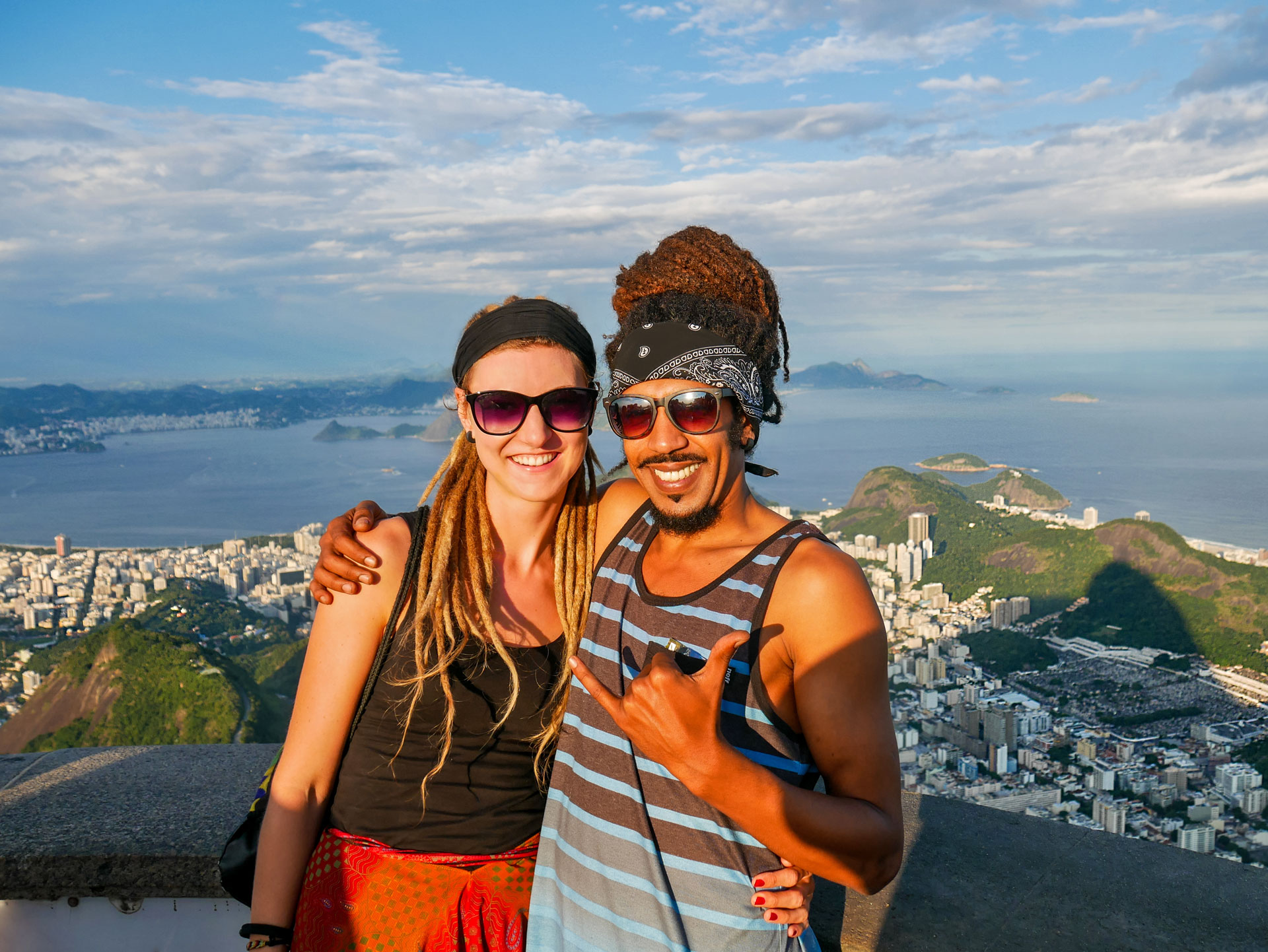
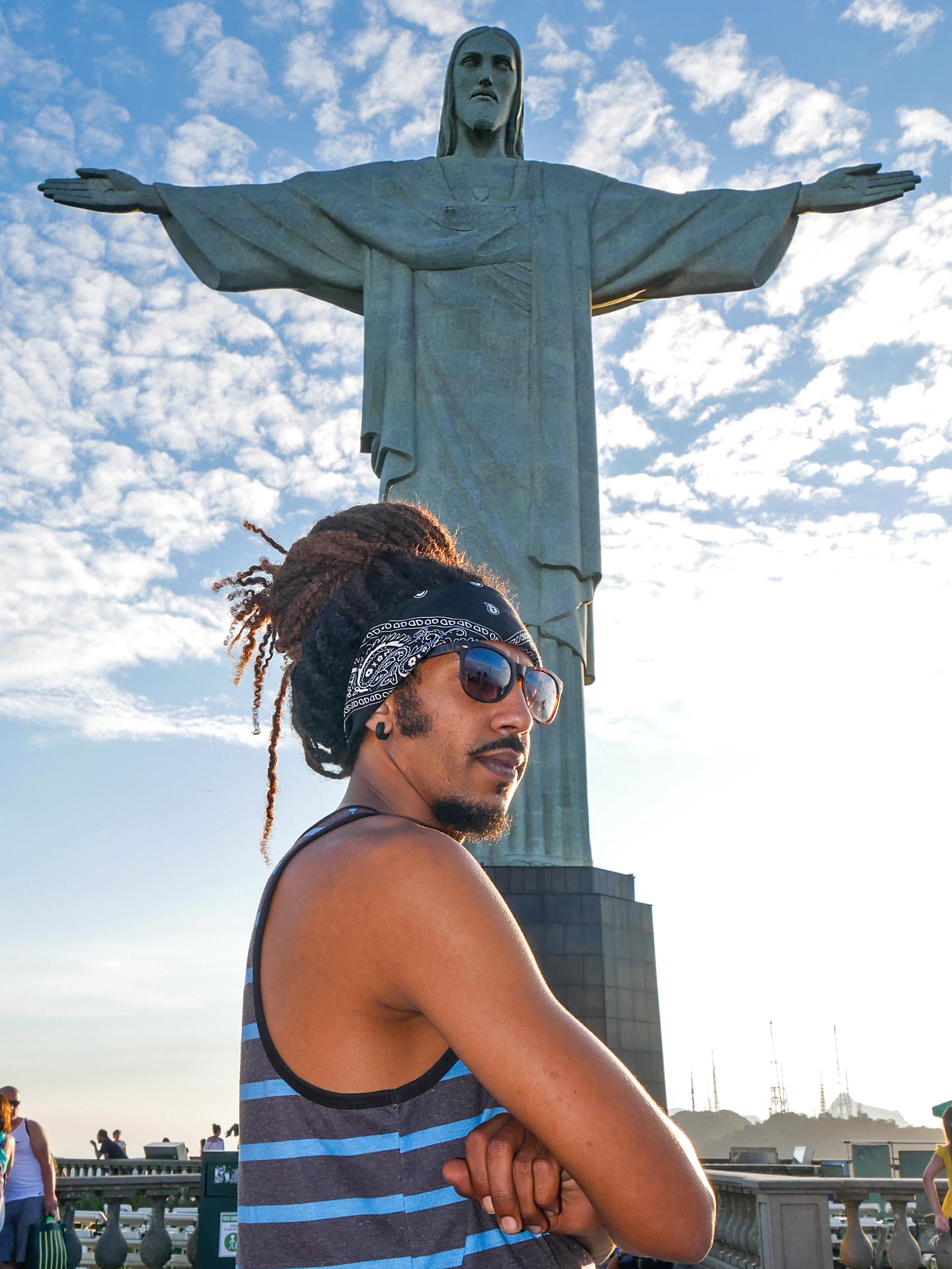
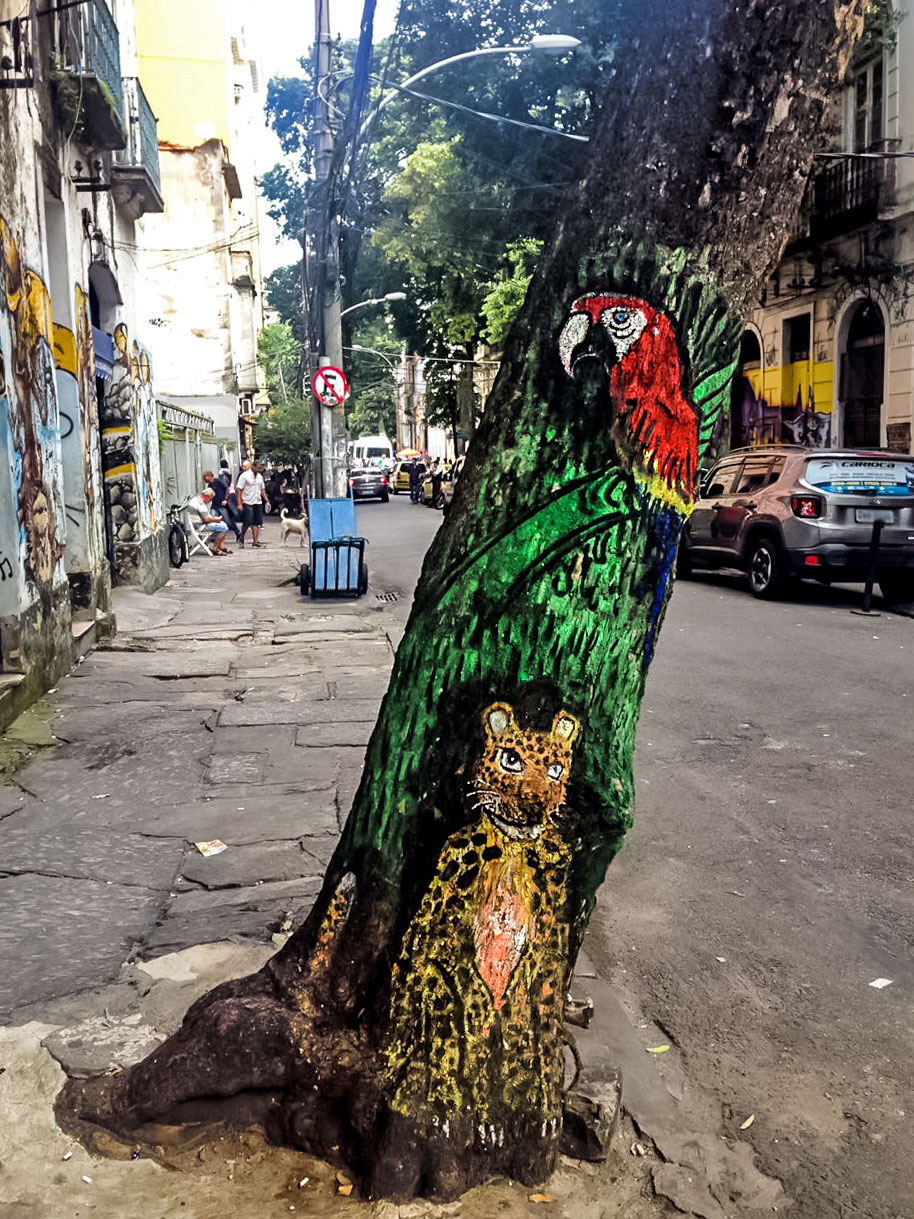
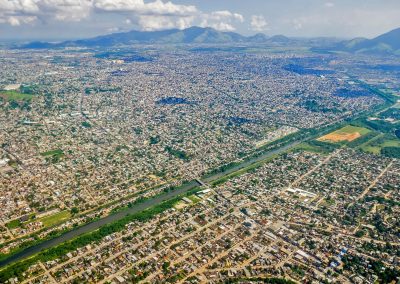
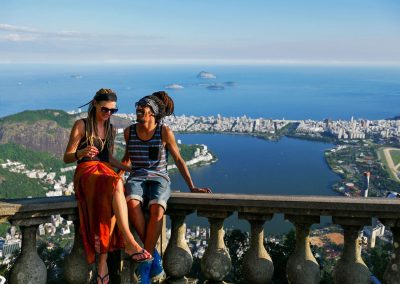
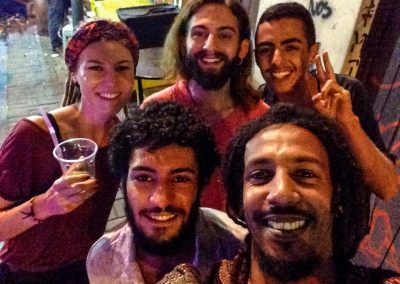
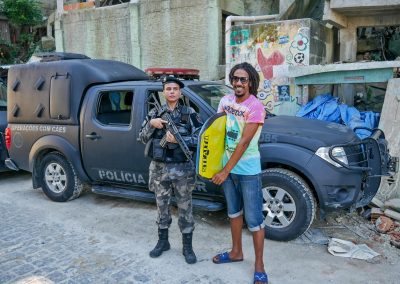
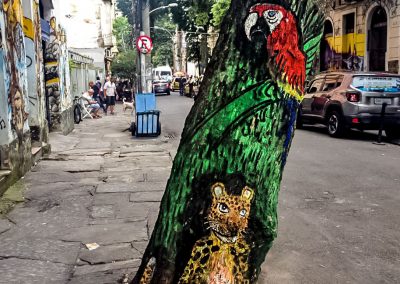
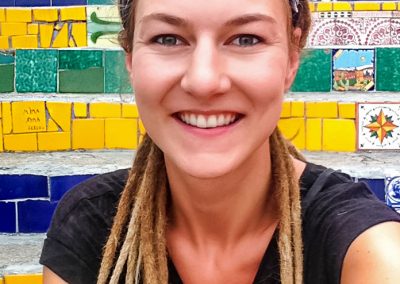
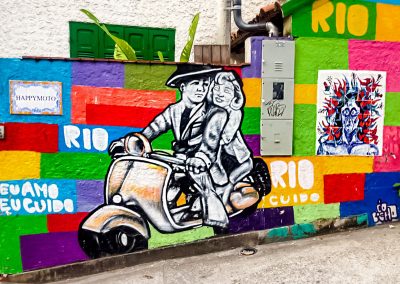
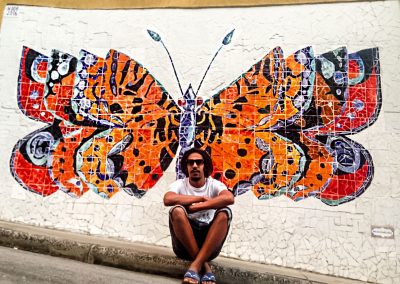
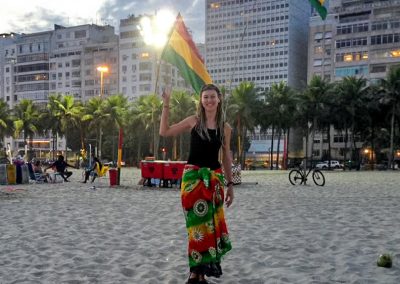
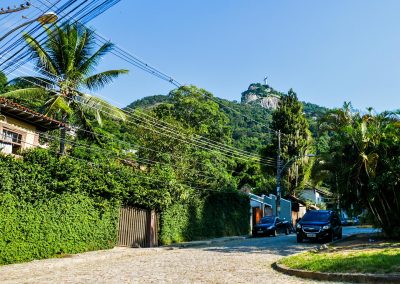
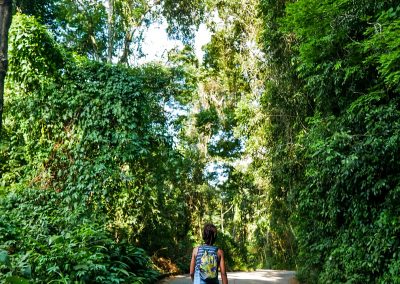
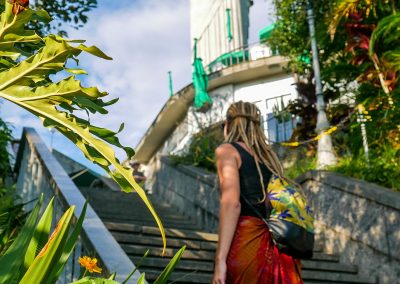

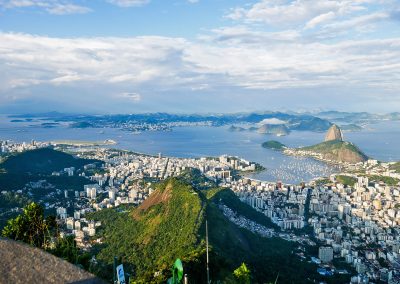

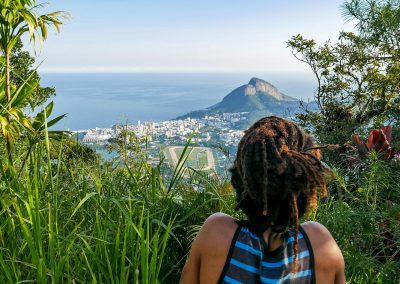
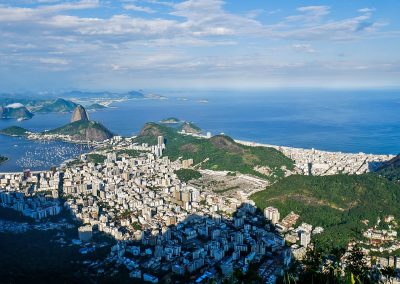
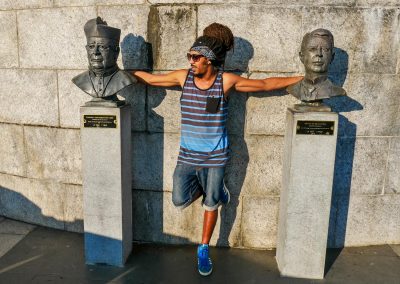
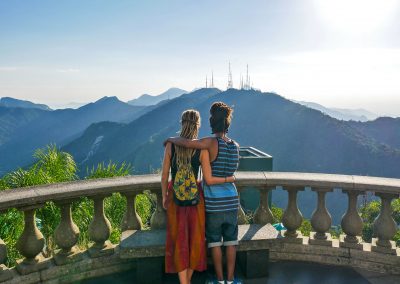
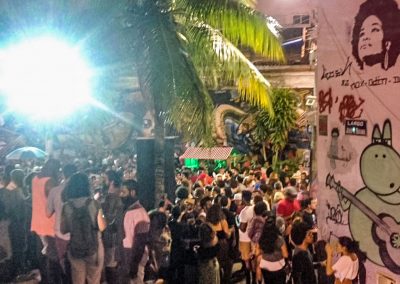
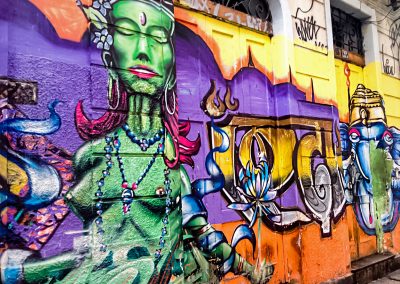
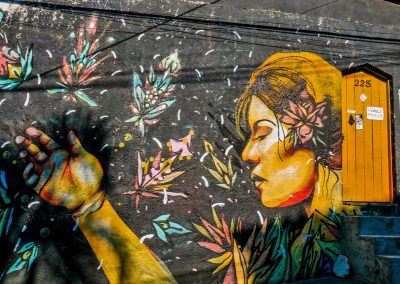
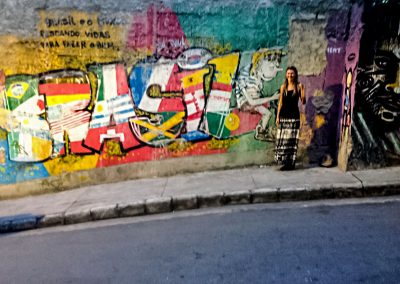



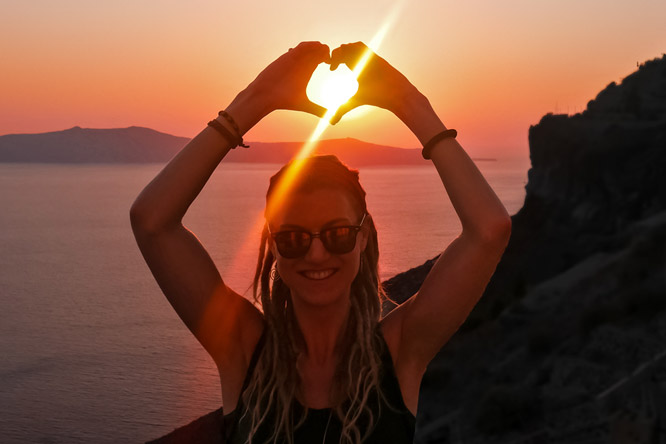
0 Comments